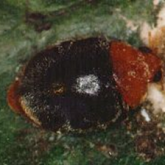Cryptolaemus (mealybug ladybird)

Cryptolaemus ladybird adult
© Queensland Government

Cryptolaemus ladybird larvae
© D Murray Queensland Government
Cryptolaemus is an Australian native ladybird beetle.
Both adults and larvae are effective natural enemies of mealybugs and many species of soft-scale insects.
Scientific name
Description
Adult beetles are around 4mm long and have:
- an orange head and thorax
- black wing covers.
May be confused with
Cryptolaemus larvae look like their mealybug prey and can be easily confused with them. Cryptolaemus have chewing mouthparts and longer waxy filaments than mealybugs.
Green lacewing larvae that have been feeding on mealybugs (and camouflaging themselves with mealybug bodies) may also be confused with cryptolaemus larvae.
Distribution and habitat
Present in all grain-growing regions.
Hosts
Adult beetles and young larvae feed on mealybug eggs and young stages. Large cryptolaemus larvae can consume adult mealybugs.
Cryptolaemus will also eat a range of scale insect species.
Life cycle and ecology
- Adult female beetles lay eggs directly into mealybug egg masses.
- Larvae grow to about 5mm long and are covered in waxy filaments.
- The full life cycle takes 4–7 weeks, depending on temperature.
Factors that influence effectiveness
Cryptolaemus are commercially available for inundative release. They do best at temperatures around 28°C.
Pesticide residues may slow or prevent cryptolaemus establishing.
- Broadspectrum pesticides such as organophosphates, carbamates and synthetic pyrethroids are particularly toxic.
- Ladybirds are also very sensitive to indoxacarb and high rates of clothianidin.
- Some insect growth regulators (IGRs) can be moderately toxic to predatory beetles.
Further information
- Cryptolaemus are available for innundative release—Bugs for Bugs